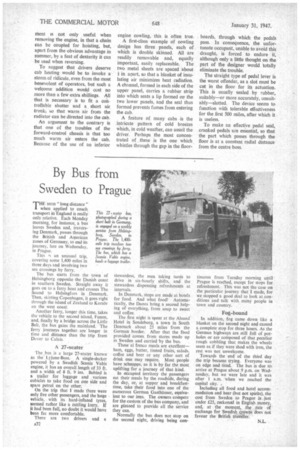By Bus from Sweden to Prague
Page 34

If you've noticed an error in this article please click here to report it so we can fix it.
THE term " long distance' when applied to coach transport in England is really only relative. Each Monday morning, for instance, a bus leaves Sweden and, traversing Denmark, passes through the British and American zones of Germany. to end its journey, late on Wednesday, in Prague.
This ,s an unusual trip, covering some 1,400 miles in three days and involving two sea crossings by ferry.
The bus starts from the town of Helsingborg opposite the Danish coast in southern Sweden. Straight away it goes on to a ferry boat and crosses The Sound to Helsingfors in Denmark. Then, skirting Copenhagen, it goes right through the island of Zealand to Kers& on the west coast.
Another ferry, longer this time, takes the vehicle to the second island, Funen. and, finally by a bridge across the Little Belt. the bus gains the mainland. The ferry journeys together are longer in time and distance than the trip from Dover to Calais.
A 27-seater The bus is a large 27-seater known as the Lyjune-Buss. A single-decker powered by a Swedish Scania Vabis engine, it has an overall length of 33 ft. and a width of 8 ft. 9 ins. Behind is a trailer for luggage and various cubicles to take food on one side and spare petrol on the other.
On the trip that I made there were only five other passengers, and the huge vehicle, with its hard-inflated tyres, seemed rather like a rattling lorry. lf it had been full, no doubt it would have been fat more comfortable.
There are two drivers and a
stewardess, the men taking turns to drive in six-hourly shifts, and the stewardess dispensing refreshments at intervals.
In Denmark, stops are made at hotels for food. And what food! Automatically, the Danes bring a second helping of everything, from soup to sweet and coffee.
The first night is spent at the Alsund Hotel in Sondeborg, a town in South Denmark about 25 miles from the German border. After that the food provided comes, from stores made up in Sweden and carried by the bus.
These al fresco meals are excellent— ham, eggs, butter, tinned fruits, salads, coffee and beer or any other sort of drink one may require. Most people have schnapps, as it is by far the most uplifting for a journey of that kind.
In occupied territory the passengers eat their meals by the roadside, during the day, or, at supper and breakfasttime, take their food into one of the numerous German Gasthauser, equivalent to our inns. The owners compete for the custom of the bus company, and are pleased to provide all the service they can.
Normally the bus does not stop on the second night, driving being con tinuous from Tuesday morning until Prague is reached, except for stops for refreshment. This was not the case on the particular journey that I made, for we stopped a good deal to look at con-, ditions and talk with many people in town and country.
Fog-bound
In addition, fog came down like a blanket on the second night and caused a complete stop for three hours. As the German highways are still full of potholes or are composed of that peculiar rough cobbling that makes the wheels seem as if they were shod with iron, the rest was not unwelcome.
Towards the end of the third day the trip became trying. Everyone was on edge and tired. The bus is due to arrive at Prague about 9 p.m. on Wednesday. but we were late and it was after 1 a.m, when we reached the capital city.
Including all food and hotel accommodation and beer (but not spirits), the cost from Sweden to Prague is just under £25, reckoned in English money, and, at the moment, the rate of exchange for Swedish l crowns does not favour the British thither.












































































